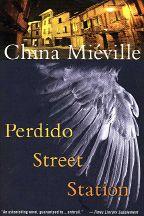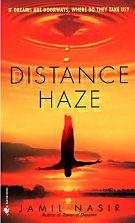Science Fiction: The 101 Best Novels 1985-2010 (34 page)
Read Science Fiction: The 101 Best Novels 1985-2010 Online
Authors: Damien Broderick,Paul di Filippo

Faber employs his clinical yet gorgeous prose like a scalpel across the reader’s sensibilities, particularly when unflinchingly describing the feedlot and abattoir technology of the aliens. His work resembles the early Ian McEwan of
The Cement Garden
era, the medical precision of Michael Blumlein, or classic J. G. Ballard, particularly in his use of outré metaphors. Here is Isserley’s estimation of a Homo sapiens penis. (Recall that she thinks of herself as “human” and Earthlings as animals.) “His penis was grossly distended, fatter and paler than a human’s, with a purplish asymmetrical head. At its tip was a small hole like the imperfectly closed eye of a dead cat.”
But Faber’s most empathetic and analytical passages are reserved for his tortured heroine. Despite her unthinking, evil ways, we identify utterly with her dilemma, thanks to Faber’s narrative magic, feeling every ounce of self-disgust and despair, every pain in her racked limbs (which bear the allegorical freight of a human transsexual, too). This is the true miracle of the novel: we realize that the worst horror is that inflicted by aliens upon the least of their kind, not by aliens upon their cattle.
Of course, numerous satirical or Swiftian themes abound in the book. Colonialism, elitism, carnivore behavior, workplace automatism, corporate loyalty, bleeding-heart cluelessness, even foodie decadence (pay attention to how the alien chef gloriously describes marinating techniques and other such kitchen-show staples), all come in for a sound drubbing. But paramount over any such skewering is the portrait of a woman, however alien, coming to grips with her ethical choices and her final realization that a bad life cannot be lived rightly.
62
China Miéville
(2000)

WHEN CHINA MIÉVILLE’S
towering phantasmagorical second novel,
Perdido Street Station,
gained the Arthur C. Clarke Award in the UK for best novel of 2000, readers had a strong inkling that a major new talent had arrived on the scene. But the full depth of Miéville’s future accomplishments could hardly be fully intuited at that moment. A rapid succession of
sui generis
books. The establishment by example of a whole new subgenre—the New Weird—and the personal authorial victory of widespread mainstream recognition, with his 2011 offering,
Embassytown
, earning coverage in such unlikely venues as
Entertainment Weekly
magazine.
None of this is undeserved. With his Bas-Lag series of three books to date, Miéville follows in the tradition of Wyndham Lewis, Alasdair Gray and Mervyn Peake, pulling off the most impressive act of narrative “subcreation” (to employ Tolkien’s term for the literary instantiation of an entire “secondary world”) in ages. These books, conflating hip urbanism, realpolitik and outré flights of fancy, make one take heart for the vitality of what can at times seem like a played-out, doddering genre.
The world of Bas-Lag exists akimbo from our familiar fields, dappled, eccentric, unthinkable and hypnotic. And yet, and yet—how ultimately true and pertinent to all that we hold dear are the people and issues and living conditions encountered in this skewed mirror. The engaging, repellent city of New Crobuzon, where all the intricate loops of Miéville’s tale tangle, is rendered with a combination of minute specificity and bold strokes. The swamps and fens, alleys and aerial trams, insane monuments and crumbling slums are impastoed with Miéville’s precise and rich prose: “In the outline of stillborn streets shacks of concrete and corrugated iron blistered overnight. Inhabitation spread like mould.” Yet the text never grows clotted, but instead, thanks to the constant action, remains compulsively readable.
Several off-kilter kinds of technology blend with various magics to render New Crobuzon a Victorian parody, yet with its own character. Not quite a dystopia or police state, the polity is still heavy-handed and repressive, filling the evil half of the moral equation. But the counterforces of good in this scenario are themselves a base and motley lot, lusty, unrepentant and truly alive. Mostly thieves and artists, they all revolve around one rogue scientist named Isaac Dan der Grimnebulin. Through Isaac’s ill-considered researches a horrible threat, the slake-moths, are loosed upon the city, and the bulk of the book deals with the battle against these
Aliens
-style predators.
There are scenes here which, like the captivating patterns of the slake-moths, are impossible to expunge from memory. If I mention an aerial battle that involves a blindfolded man with a dog strapped to his back—and the dog is issuing the orders!—then you’ll have the barest hint at the wonders that wait within.
Miéville also accomplishes the nigh-impossible: social commentary on our own world without weighty preaching. The situation of New Crobuzon’s working poor, so reminiscent of the lot of citizens in Brazilian favelas and other global slums, comes across with great impact. Life is entropy with a grin:
Perdido Street Station
makes this abundantly clear, as does Miéville’s Bas-Lag follow-ups,
The Scar
and
Iron Council
.
A massive nautical tale of obsession, magic and outlaw existence,
The Scar
contains enough plot for several lesser novels. The neo-Gothic, steampunkish city of New Crobuzon is in turmoil, following the events of the earlier book. Instead of producing a direct sequel to
Perdido Street Station
, Miéville chose to go off at an angle to his established path, opening up broader vistas of his entrancing, unique world of Bas-Lag. Whereas the previous book never ventured outside the confines of New Crobuzon, this book ranges across the map of Bas-Lag, revealing to us more history, more geography, more cultures. It was a bold, expansive move, and much was gained by this tactic. Miéville’s subcreation becomes more extensive, more of a whole organic quilt rather than a single intensely embroidered patch.
There’s a plethora of wonders here. Miéville’s fecund imagination conjures up vivid images on every page. His alien races are truly alien, and his humans are exotically colored. Uther Doul, an Elric-style outcast, has to be one of the best literary pirate figures ever written. And the supporting character named Tanner Sack emerges as one of the most sympathetic. Set-piece by set-piece, Miéville knocks you on your butt. Whether presenting us with giant mosquito women or undead vampires, Miéville knows how to ratchet up the suspense. And the overall tale matches the apocalyptic novels of Mark Geston in its levels of insane damnation. Finally, Miéville cleverly gets us to reverse our allegiances from New Crobuzon to Armada in the exact same fashion that his heroine Bellis does.
For his fourth novel,
Iron Council,
Miéville returned to the grotesquely alluring world of Bas-Lag and its mightiest city, New Crobuzon, rewarding his fans. Yet the third entry in the series is eminently readable for novices also, featuring a new cast of characters and easy immersion in the various species, politics and culture of New Crobuzon.
The tale follows two parallel tracks—symbolically quite fitting, seeing that a mighty railroad train lies at the heart of the novel—which converge toward the climax. Between alternating episodes from both narrative tracks, we learn in an extended flashback the story of “golem master” Judah Low’s young manhood, how he worked for the grand, monumentally crazy scheme of building a railway across the treacherous terrain of Bas-Lag, and how he helped form the Iron Council when he and others stole the vehicle that was essential to the enterprise, converting it into a “perpetual train” of independence and freedom. Eventually a dozen different subplots cohere, culminating in a massive battle for the soul of New Crobuzon, with enormous sacrifices—sometimes at deadly cross-purposes.
Miéville succeeds in his ambitious program here due to a number of factors. First are his sheer language abilities. Like Ian MacLeod, a fellow British fantasist, Miéville writes gorgeous sentences that are obviously crafted with painstaking effort, yet which read smoothly and elegantly, sheer poetry. Whether he’s describing monsters such as the “inchmen”—“Colossal and grossly tubate, a caterpillar body studded with tufts, ventricles opening and closing sphincters, dun with warning colors. The man-torso congealed into the front of that yards-long body...”—or gothic buildings or convoluted action sequences, Miéville employs diction and syntax in idiosyncratic ways, not content to fall back on clichés. Secondly, Miéville exhibits immense fertility of both plot and setting. The dozens of “xenian” sentients who share Bas-Lag with the humans, the welter of incidents that make up this history, all spew forth in convincing multitudes. Bas-Lag possesses the inexhaustibility of the real world.
Next comes Miéville’s allusiveness. Literary precedents—Tolkien, Vance, Peake—are playfully invoked (consider that one dire battle is resolved by the unexpected arrival of horse-clan warriors), but so are real-world milestones. The war between New Crobuzon and Tesh bears comparison to the conflict between the USA and Iraq. The revolt of the underclass in the city harks back to Paris, 1968. And could the Mayor of new Crobuzon be Maggie Thatcher? No doubt! Anchoring his tale in both the literature of the fantastic and real history gives it a science fictional solidity that other more rarefied fantasies lack. Miéville’s sense of multiculturalism is another plus. His creation is not a whitebread affair, but partakes of many different flavors suitably transmogrified: Hispanic, European, African, Anglo. Finally, Miéville’s flair for rich characterization is pronounced.In short, what Miéville has accomplished is to render a world both utterly estranged from ours, yet eerily congruent, and to populate it with figures who breathe and bleed and love, and whom we may care deeply about.
63
Jamil Nasir
(2000)

DISTANCE HAZE
trembles in the phase space between Douglas Hofstadter’s
Gödel, Escher, Bach
and Oliver Sacks’s
An Anthropologist on Mars
—or maybe Dennis Overbye’s
Lonely Hearts of the Cosmos
and
Buffy the Vampire Slayer
. The words flow like honey, with just enough grains of pepper to gravel the tongue; it is a book for the ear, and the inner eye.
Sf writer Wayne Dolan, something of a dud after five books (success with his first two, the next flopped, his marriage crumbling, his child lost to him), visits the lavishly endowed Deriwelle Institute for the Electrical Study of Religion. He hopes to reignite his flagging career with a popular science account of crackpot but enthrallingly New Agey doings at the Institute, where Nobel laureates and workaday drudges seek the spirit in the lab. Dolan plans a book akin to bestsellers about the Santa Fe Institute, driven in doing so to examine the murk in the depths of his own self-damaging and dissatisfied soul.
The key feature of
Distance Haze
is that, like quite a few good current sf books, it is genuine literature. That is quite an impressive achievement, since the storyline itself is a string of silly pranks, one tasty absurdity mounted on another. But Nasir’s near-science postulate is based on genuine recent work in cognitive neuroscience. Reputable scientists do claim to have located a “god module” in a portion of specialized temporal lobe circuitry that lights up preferentially during religious experiences. Lesions near this region can precipitate “hyper-religiosity,” a clinical disorder. It is not a stretch that certain genome sequences encode these modules, and might in future be switched on or off in the brain of a developing infant. Might a person mature from childhood without any intrinsic, evolved bent for faith? If so, would he or she be cruelly impaired, hurled into inconsolable Sartrean nausea and meaninglessness—or, rather, liberated from programmed illusion to an unprecedented degree? Could such a transformation be worked on the brain of an adult? It is a topic that has been explored by Greg Egan, the master of this sort of speculation. But Nasir writes more joyously and hurtingly than Egan.